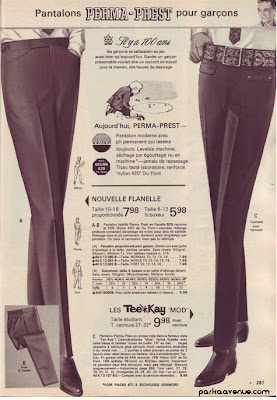In a previous post, I described in detail all the work that
went into planning and building a mezzanine for my loft. Again, I have to
acknowledge the time and skilled craftsmanship my father provided.
That post might have lacked in the Mod department but this
will surely make up for it. Now we enter my terrain: the decorating. This is
what lights my fire and gets my creative juices flowing. I love this stuff and
luckily I have the most accommodating wife that pretty much gives me carte
blanche. How wonderful is she?
Most of the apartment is inspired by mid-century modern and
Scandinavian design. I will sometimes dwell a bit in the 70s. Sleek teak
furniture is preeminent throughout the pad so I was looking for something
different for the mezzanine. I was aiming for the Pop / Space Age / Mod look of the sixties. I started
making the rounds of my local flea markets and antique shops looking for
anything Atomic, futuristic, mainly made of plastic. White furniture would
guide my color pallet with splashes of bold color thrown in.
One of the first new pieces I acquired was this Treco
credenza. Made in Canada in the early 70s, it’s something that you can still
find second hand relatively easily today. The drawers came in a multitude of
colors: white, yellow, lime green with red being one of the more popular choices. I
have a certain fondness for that design because my younger sister had a red and
white set in her bedroom while I was growing up. In fact, my godfather still
has it in his basement.
Next came the dream chair. I always fantasized of having my
own Eames lounge chair. If there is ever an iconic piece of modern furniture,
this is it! Now since I don’t have a spare 6000 to 7000 dollars lying around
for an original, I had to settle for an accurate, well-made, rose wood vintage
copy. I have to thank my friend Stephane from Du Design, Du Retro et du Kitsch for seeking it out for me. Be aware of the cheaply made
Chinese facsimiles currently invading the market.
I did manage to put my hands on an early example of a real
Eames DWC chair. The more common model has the wooden legs, slanted seat and
is often seen in a light teak. The late 50s model has chrome legs. It matches
perfectly with the existing tubular steel railing of the mezzanine. I was
fortunate to come across the chair in black. The dark grain makes it stand out
and ties it in with the lounge chair.
The other pieces surrounding the lounge chair include a
white, plastic, vintage accent Kartell table and its sister magazine rack.
Again, if you are a purist, you’ll go for the original piece even if Kartell
still produces them. Like the popular expression states: “They just don’t make
them like they use too”. The newer ones are made, you guessed it, in China and
are, in my opinion, of lesser quality. I guess it’s the equivalent of buying a
Northern Soul record on the original label or buying a perfectly acceptable
re-issue. For some reason, if the price is right, I’ll always go for the
original. I prefer a piece that has history, character and even a few flaws.
The Dynamite 8 Panasonic 8-track player is widely recognized
as a classic piece of the era. With its plunger like channel selector, it’s a
real blast to use. Next to it is a perfect example of timeless modern design with this Braun ventilator.
The lighting was mostly flea market finds and easy on the
pocket book. This small chrome lamp was a steal at 25$ and fits the overall
look.
This modern Scandinavian wall sconce helps create a soft,
groovy atmosphere.
To serve as a reading lamp, I found this 50s atomic
chandelier. (Thanks again Stephane!) All the lamps are connected on a circuit
that is controlled by a dimmer. I have dimmers on every outlet I possibly can
in the loft. With them… voilà!... instant mood. Next to it is the Christmas present I got from my wife. It’s
an oversized artistic oil-on-canvas replica of the classic Mod anthem My
Generation by The Who with the painted sleeve. You can find a wide selection of other titles, like the
2-Tone favorite Gangsters by The Specials at the Super Size Art website.
A few accessories complete the lot like this sought-after
Panasonic TR 005 Orbitel television reminiscent of a flying saucer.
I also had the rare opportunity to buy this Weltron 2005
turntable from a fellow Mod who was moving back to his native Helsinki and
couldn’t pack it in his suitcase. I’m looking to incorporate it in the decor
but haven’t found a suitable table to put it on yet.
Weltron is a Japanese company that flourished in the 70s and
was praised for its innovative design. This table model comes with integrated
speakers but it can be hooked up to a separate set of speakers. It also came in a flashy yellow color.
The bedroom section is meant to be warm and cozy that’s why
mid-century modern teak furniture was chosen. I always loved my bed’s vintage headboard for its practical
feature. It has two sliding squares that can glide on the main frame to
accommodate a queen or king size bed.
I was looking forward to finishing the mezzanine to finally
hang my new wall art. First is this beautiful painting on a recycled record
made by Texas native, Patricia Rodriguez. Make sure to have a look at some of
her work at Tiger Bee Arts. You will definitely find some Mod friendly themes.
Fancy a painting of you on your Lambretta? She will even accept commision work.
Finally, there’s this minimal and modern painting of the
female form that I had for a while. The final touch to our little Mod retreat.





















































